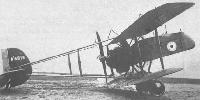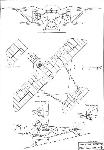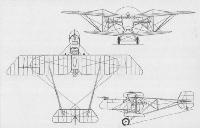
Описание
Страна: Великобритания
Год: 1917
Fighter
Варианты
- RAF - F.E.9 - 1917 - Великобритания
- RAF - N.E.1 - 1917 - Великобритания
- RAF - A.E.3 - 1918 - Великобритания
- P.Hare Royal Aircraft Factory (Putnam)
- P.Lewis The British Fighter since 1912 (Putnam)
- F.Mason The British Fighter since 1912 (Putnam)
- W.Green, G.Swanborough The Complete Book of Fighters
- J.Bruce British Aeroplanes 1914-1918 (Putnam)
- H.King Armament of British Aircraft (Putnam)
-
J.Bruce - British Aeroplanes 1914-1918 /Putnam/
The first F.E.9 with ailerons similar to those of the original B.E.12a.
-
F.Mason - The British Fighter since 1912 /Putnam/
The first F.E.9, A4818, with single-bay wings and displaying the heavilly overbalanced ailerons.
-
K.Delve - World War One in the Air /Crowood/
Seen at Hounslow sometime in 1917 is FE9 A4818; it has extensive graffiti around the forward fuselage but this is unfortunately unreadable. Note the long overhang to the top wing and the huge aileron balance areas. Designed as a two-seat fighter-reconnaissance replacement far the FE2b, the type arrived in France in the summer of 1917 for trials but in the event was only produced in limited numbers.
-
P.Hare - Royal Aircraft Factory /Putnam/
The anachronistic Royal Aircraft Factory FE 9 two-seat reconnaissance fighter was powered by a pusher-mounted 200hp Hispano-Suiza and first flew in the early spring of 1917. As the Bristol F2B was already more than adequately meeting this requirement, it was not surprising that this design with its top level speed of 105mph at sea level, plus faltering climb that took 8 minutes 25 seconds to reach 5.000 feet was abandoned. The only machines to fly were the three development aircraft, the first of which, Serial no A 4818, is seen here.
-
J.Bruce - British Aeroplanes 1914-1918 /Putnam/
The second F.E.9, A.4819, showing the two-bay interplane bracing and modified fin and rudder. In this photograph (dated November 3rd, 1917) the aircraft is seen with the second type of ailerons to be tested.
-
J.Bruce - British Aeroplanes 1914-1918 /Putnam/
Left: The first F.E.9, A.4818, fitted with a rudder of the same basic shape as that of A.4819 but with an enlarged balance area. Photograph dated May 10th, 1917.
Right: A.4818 with fin removed and small balanced rudder. Photograph dated September 19th, 1917. -
J.Bruce - British Aeroplanes 1914-1918 /Putnam/
Left: The first F.E.9 with the original ailerons and final form of rudder. Photograph dated October 24th, 1917.
Right: The first F.E.9 with the third type of ailerons and final form of rudder. Photograph dated October 24th, 1917. -
W.Green, G.Swanborough - The Complete Book of Fighters
The F.E.9 is seen with the original single-bay wings.
P.Hare Royal Aircraft Factory (Putnam)
F.E.9
Bearing in mind that the F.E.9 was designed about September 1916, as a replacement for the F.E.2 series, it is rather surprising that it was yet another pusher. By that time the availability of gun synchronisation systems had rendered the pusher concept obsolescent, although every possible effort was made to reduce the layout's inherent disadvantages to a minimum.
The F.E.9 was designed around the 200hp geared-drive Hispano-Suiza, and its nacelle was positioned well above the mid-gap position, to afford the observer a reasonable rearward field of fire over the upper wing without the need to resort to the acrobatics required in the F.E.2. Two Lewis guns were provided, each on a pillar mounting, one firing forwards and one to the rear. It was planned that the machine should carry a third gun for the pilot's use, mounted on the starboard side of the nacelle, but no evidence has been found that this weapon was installed. The neat undercarriage had short but effective oleos attached to the lower centre-section, and the tailskid arrangement echoed that of the S.E.5 and R.E.8.
Dual controls were provided, those in the observer's cockpit comprising two control columns, one operating the elevators and the other controlling the rudder, as it was felt that a conventional rudder bar would obstruct the observer's freedom of movement as he performed his normal duties. Since these controls were intended only for use in an emergency, it was not considered necessary to provide any aileron controls, turns being made on rudder alone.
Steel-tube N-struts secured the nacelle to the single-bay wings, which were of unequal span, the upper-wing extensions being supported by bracing wires and inverted triangular kingposts, as was common Factory practice. Ailerons were fitted to the upper wing only, and had large horn balances, being similar to those originally fitted to the B.E.12a. As in the F.E.8, the tailbooms met at the tailplane spar. The fin was almost semi-circular, and the rudder was unbalanced.
With what, unfortunately, turned out to be misplaced confidence, a batch of twenty-four aircraft was put into production 'off the drawing board', using the Factory's own facilities.
The first of these, A4818, was completed by the beginning of April 1917, and test flying was undertaken by Roderic Hill, who found the rate of climb disappointing and the handling unpleasant, particularly during left-hand turns, a characteristic he attributed to the ailerons being over-balanced and the rudder being of insufficient power.
On 6 June Hill flew the aircraft to the Aircraft Depot at St Omer for service trials, apparently without any modification to its control surfaces. Lt Clark of 13 Squadron, an experienced observer who was taken up in it, reported that, from the observer's point of view, the field of fire was very good and that it was easy to fly with its odd controls. Pilots were less enthusiastic, and on 9 June Maj-Gen Trenchard reported that, although the view was excellent, the machine itself was already a year out of date and of no use to the RFC. He recommended that experiments with the F.E.9 should be stopped, and suggested that putting the 200hp Hispano-Suiza into it was a waste of a really good engine. At this stage it appears that the nacelles had been completed for all twenty-four machines, and at least two more airframes were well advanced and were eventually completed.
The Factory's design staff appear to have regarded the type's poor handling as a challenge to be overcome at all cost (perhaps the correct attitude to take in an aeronautical research centre), and when A4818 returned to Farnborough it underwent a lengthy series of modifications to its control surfaces. A new, high-aspect-ratio rudder of reduced area, incorporating a small horn balance, was fitted, and then the fabric was removed from the fin. Later a large balanced rudder of lower aspect ratio was substituted, without a fin. At the same time the aileron balance areas were progressively reduced.
By mid-October A4818 had been joined by the second machine, A4819, which had the high-aspect-ratio rudder and redesigned wings with two-bay interplane bracing, the outer pairs of struts being raked outwards to support the upper wing extensions and thus eliminating the need for kingposts. The ailerons had smaller horn balances than those of A4818. The second machine eventually saw service with No 78 (Home Defence) Squadron, and was written off in a landing accident at Biggin Hill the following winter.
The third and final example, A4820, which was completed ready for inspection on 1 November, also had two-bay wings. By this time a third type of aileron, with the balance area still further reduced, had been fitted to A4818 and, since this type was considered to give a marked improvement in handling, it is probable that it was also fitted to A4820.
The fates of the first and third F.E.9s are unknown, but A4820 is last recorded as undergoing engine tests in January 1918, and A4818 continued to serve as a research vehicle for investigations into aircraft control at least until March of that year. Thereafter the F.E.9 faded into oblivion, the information obtained from its protracted development and testing being used in the design of its successors, most notably the N.E.1.
Powerplant: 200hp Hispano-Suiza V-8
Dimensions:
span 40ft 1in (upper);
37ft 9 1/2in (modified ailerons);
29ft 5 1/4in (lower);
wing area 365 sq ft;
length 28ft 3in;
height 9ft 9in.
Weight: 2,480lb (loaded).
Performance:
max speed 105mph at sea level;
ceiling 15,500ft;
climb 5min to 3,000ft.
Описание:









